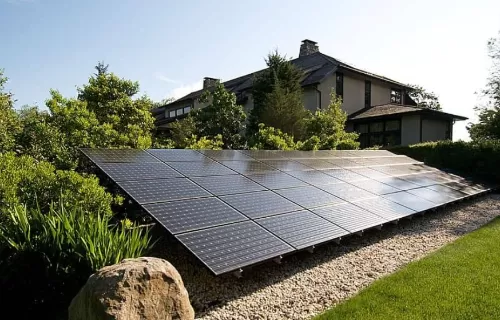Click to Get Big Benefits

This guide provides an overview of how solar panels work, their benefits, types of solar panels, and key considerations for installing them.
How Solar Panels Work
Solar panels, also known as photovoltaic (PV) panels, convert sunlight into electricity through a process called the photovoltaic effect. Here’s a basic overview of how they work:
Photovoltaic Cells:
Components: Solar panels consist of many photovoltaic cells made from semiconductor materials such as silicon.
Process: When sunlight strikes the cells, it excites electrons in the semiconductor material, generating a flow of electricity.
Direct Current (DC) Electricity:
Generation: The photovoltaic cells generate direct current (DC) electricity. DC flows in one direction, which is suitable for the internal workings of the solar panel but needs conversion for general use.
Inverter:
Conversion: An inverter converts the DC electricity into alternating current (AC), which is the type of electricity used by most home appliances and the power grid.
Electrical System Integration:
Usage: The converted AC electricity is then used to power your home or business. Any excess electricity can be fed back into the grid or stored in batteries for later use.
Benefits of Solar Panels
Environmental Impact:
Renewable Energy: Solar power is a clean, renewable energy source that reduces reliance on fossil fuels and lowers greenhouse gas emissions.
Sustainability: Solar panels help reduce the carbon footprint and contribute to a more sustainable energy system.
Cost Savings:
Reduced Energy Bills: By generating your own electricity, you can lower your utility bills. Over time, the savings can offset the initial cost of installation.
Incentives and Rebates: Many governments offer incentives, rebates, or tax credits to reduce the cost of solar panel installations.
Energy Independence:
Self-Sufficiency: Solar panels provide a degree of energy independence, reducing reliance on external energy sources and increasing resilience against power outages.
Low Operating Costs:
Maintenance: Solar panels have low maintenance requirements. Regular cleaning and occasional inspections are typically all that’s needed to ensure optimal performance.
Increased Property Value:
Value Addition: Homes and businesses with solar panel systems often see an increase in property value, as energy-efficient features are attractive to buyers.
Types of Solar Panels
Monocrystalline Solar Panels:
Overview: Made from single-crystal silicon, these panels are known for their high efficiency and sleek appearance.
Advantages: Higher efficiency, longer lifespan, and better performance in low-light conditions.
Disadvantages: Generally more expensive than other types.
Polycrystalline Solar Panels:
Overview: Made from multiple silicon crystals melted together, these panels are less efficient than monocrystalline panels but more affordable.
Advantages: Lower cost and simpler manufacturing process.
Disadvantages: Slightly lower efficiency and less aesthetically pleasing.
Thin-Film Solar Panels:
Overview: Made by depositing thin layers of photovoltaic material onto a substrate. These panels are flexible and lightweight.
Advantages: Lower cost, flexible, and lightweight, which can be advantageous for certain applications.
Disadvantages: Lower efficiency and shorter lifespan compared to crystalline panels.
Bifacial Solar Panels:
Overview: These panels have photovoltaic cells on both sides, allowing them to capture sunlight from both the front and rear.
Advantages: Increased energy generation, especially in environments with reflective surfaces.
Disadvantages: Higher cost and more complex installation.
Key Considerations for Installing Solar Panels
Assess Your Energy Needs:
Evaluation: Determine your current energy consumption and identify how much energy you want to generate with solar panels. This will help in selecting the right system size.
Check Solar Potential:
Sunlight Exposure: Evaluate the amount of sunlight your location receives. Factors such as roof orientation, shading from trees or buildings, and geographic location affect solar panel performance.
Choose the Right System:
Types: Decide between grid-tied, off-grid, or hybrid solar systems. Grid-tied systems are connected to the utility grid, while off-grid systems operate independently. Hybrid systems combine both approaches.
Evaluate Costs and Financing:
Budget: Consider the total cost of installation, including equipment, labor, and any additional components (e.g., batteries). Explore financing options such as solar loans, leases, or power purchase agreements (PPAs).
Select a Reputable Installer:
Research: Choose a certified and experienced solar installer. Look for reviews, ask for references, and verify their credentials to ensure quality installation and service.
Understand Warranties and Maintenance:
Coverage: Review the warranties provided by manufacturers and installers. Warranties typically cover performance, equipment, and installation.
Maintenance: Regular maintenance ensures the longevity and efficiency of your solar panel system. Schedule periodic inspections and cleanings as needed.
Check Local Regulations and Permits:
Compliance: Familiarize yourself with local regulations, zoning laws, and permit requirements for solar panel installation. Compliance ensures a smooth installation process and avoids potential issues.
Conclusion
Solar panels represent a powerful tool for harnessing renewable energy and reducing dependence on fossil fuels. By understanding how they work, exploring different types, and considering key factors in installation, you can make informed decisions about adopting solar technology. Investing in solar panels not only contributes to environmental sustainability but also offers potential financial benefits and increased energy independence.

All News
Others
- Terms of use
- Privacy Policy

